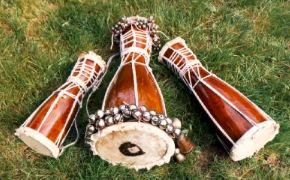Throughout the world, several types of drums had been created and were commonly used in religious ceremonies. One of these drums is the Batá drum. In its introduction in the 1820s, southwestern Nigerian people perceived this drum as an essential part of their culture.
A Batá drum is an hourglass-shaped percussion instrument that has double heads. Its two heads were not in similar size for one end is larger than the other. This instrument that originated from Yoruba and Igbo, Nigeria, is typically used for religious purposes. In fact, a religion called Lukumi and the Batá drum is closely related. During the santeria ceremonies, the drums were played to create a polyrhythmic composition. These ceremonies that use the Batá drum is sometimes called a toque, tambor de santo, or bembe. In some traditions, the Batá drum is accompanied by chekere, a shaken gourd-rattle ensemble.
In addition to that, Certain rules and rituals govern the construction, caring, playing, and handling of the Batá drum. Traditionally, the hides of non-castrated male deer or goat were used in creating the instrument. Hides of female goats, bulls, cows, and sheep were deemed unsuitable. Also, only those who are considered worthy have the right to touch or play the instrument. In the later years, although the drum’s earlier purpose is as adrum of gods, ancestors, and politicians, it is also used to convey messages. Moreover, the Batá drum can also be found in certain places in Cuba, Puerto Rico, and in the U.S.Interestingly, this drum has an impact on all aspects of life in the land of Yoruba.
Batá drum dates back from 500 years and is believed to be introduced by the Yoruba king, Shango el Rey del Tambor. However, the awareness of this instrument does not spread until the year 1800’s slave trade, wherein approximately 300,000 slaves were brought to Cuba. Eventually, the Batá drum was inducted to the culture of the Cubans and began to take on more secular uses.Subsequently, in the year 1935, the Batá drum had its first broadcast over Cuban radio for the folklore music. Since then, this Yoruba drum has been used in several music genres like jazz, timba, and hip hop. In fact, in the year 1970, the genre Batá Rock became notable with the influence of the Cuban band, Irakere. By the twentieth century, secular musicians made their appearances in the United States.
The Cuban Batá drum is consists of three sets of tapered cylinders of various sizes. The largest cylinder is called the mother drum or Iyá. The middle one is called Itótele, while the smallest is the Okónkolo. The Cuban drum is usually decorated with small chimes and bells, called Chaworo or Chaworoide. Thesebells were attached to one or two igbaju leather straps for mounting the mother drum or Iyá. However, in Nigeria, there are five sizes of the Batá drum. These drums could be played by hands or by using a leather play strap.
Meanwhile, in Matanzas, the Batá drum is played with one hand. The two heads of the Batá drum does not have the same size. The larger drum head is called enu, while the smaller head is called chacha.
Furthermore, in Yorubaland, the Batá drum has different parts. These parts include the Igi Ilu, the leather, Egi Ilu, Osan, Iro,and Bulala.
- Igi Ilu: The Igi Ilu is the wooden framework of the drum.
- The leather:There were two piles of leather attached in the Batá drum: one is to bring out the tone in the instrument, while the other is used to cover the first leather.
- Egi Ilu:The Egi Ilu that holds the leather to the wooden frame. This part of the drum is usually constructed with small bunches of thick brooms, called Igbale gbaro.
- Osan:Osan is the thick leather that serves as the wire of the drum. It also helps in holding the Egi Ilu and leather in place.
- Iro:Iro is the black substance found on the surface of the Batá drum’s leather. It is designed to give a variety of tones from the different faces of the drum.
- Bulala: is also the thick leather used to play the drum. However, nowadays, flexible plastics were used and cut to look like the Bulala

